Bathtub
What to Do if You Flush a Large Object Down the Toilet

Have you ever been in a situation where a large object gets flushed down the toilet? It can be a troublesome predicament that needs immediate attention.
Well, fear not! In this article, we will guide you through the steps you need to take to handle this plumbing crisis with ease. From assessing the situation to seeking professional help if needed, we’ve got you covered.
So, let’s dive in and master the art of toilet rescue!
Key Takeaways
- Assess the situation by examining the toilet bowl, checking for signs of leakage, and inspecting the surrounding area for water damage.
- Stop the water flow by locating and turning off the shut-off valve near the base of the toilet to prevent further water from entering the bowl.
- If possible, retrieve the object using a toilet auger or a long-handled tool with a hook, being careful not to push it further into the drain.
- If unable to retrieve the object, consider using a plumbing snake to break up the clog or hook onto the object. If the situation becomes complex, seek professional help from a plumber specializing in toilet repairs and blockage removal.
Assess the Situation
First, we need to assess the situation and determine the severity of the problem after flushing a large object down the toilet. Assessing the damage is crucial in order to take immediate action.
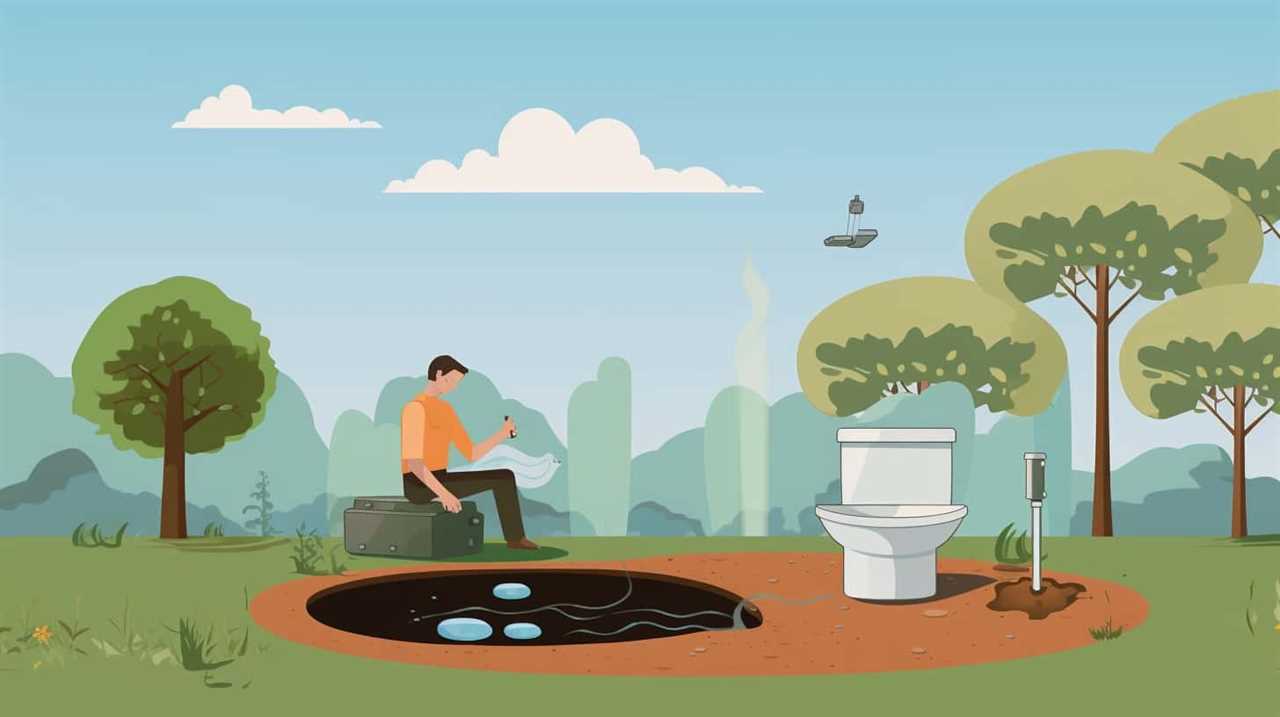
Start by examining the toilet bowl to see if it’s filled with water or overflowing. Take note of any signs of leakage or unusual sounds coming from the pipes. Carefully inspect the surrounding area for any water damage or wet spots on the floor. This will help you understand the extent of the problem and guide your next steps.
Once you have assessed the situation, you can move on to stop the water flow and prevent further damage.
Stop the Water Flow
To stop the water flow after flushing a large object down the toilet, we can use a shut-off valve located near the base of the toilet. This valve is typically a small, round knob that can be turned clockwise to shut off the water supply to the toilet.
By doing this, you can prevent any further water from entering the toilet bowl and potentially causing more damage or flooding. It’s important to act quickly in order to minimize the risk of overflowing and water damage to your bathroom.
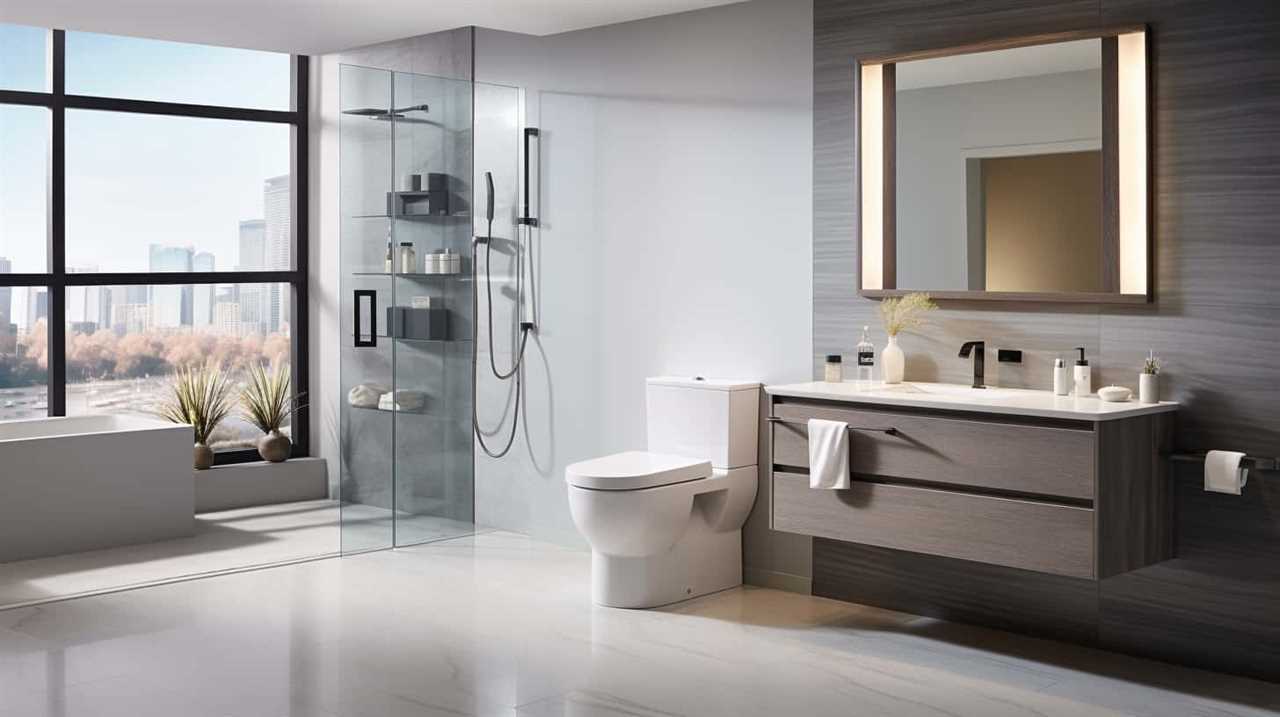
Once the water flow has been stopped, you can then proceed to assess the situation and determine the best course of action to remove the object and prevent future plumbing mishaps.
Remember to always exercise caution when dealing with plumbing issues and consider seeking professional help if needed.
Retrieve the Object (If Possible)
After stopping the water flow, we can now focus on retrieving the object from the toilet. It’s important to approach this task with caution to avoid causing further damage to the toilet.
First, put on a pair of rubber gloves to protect your hands.
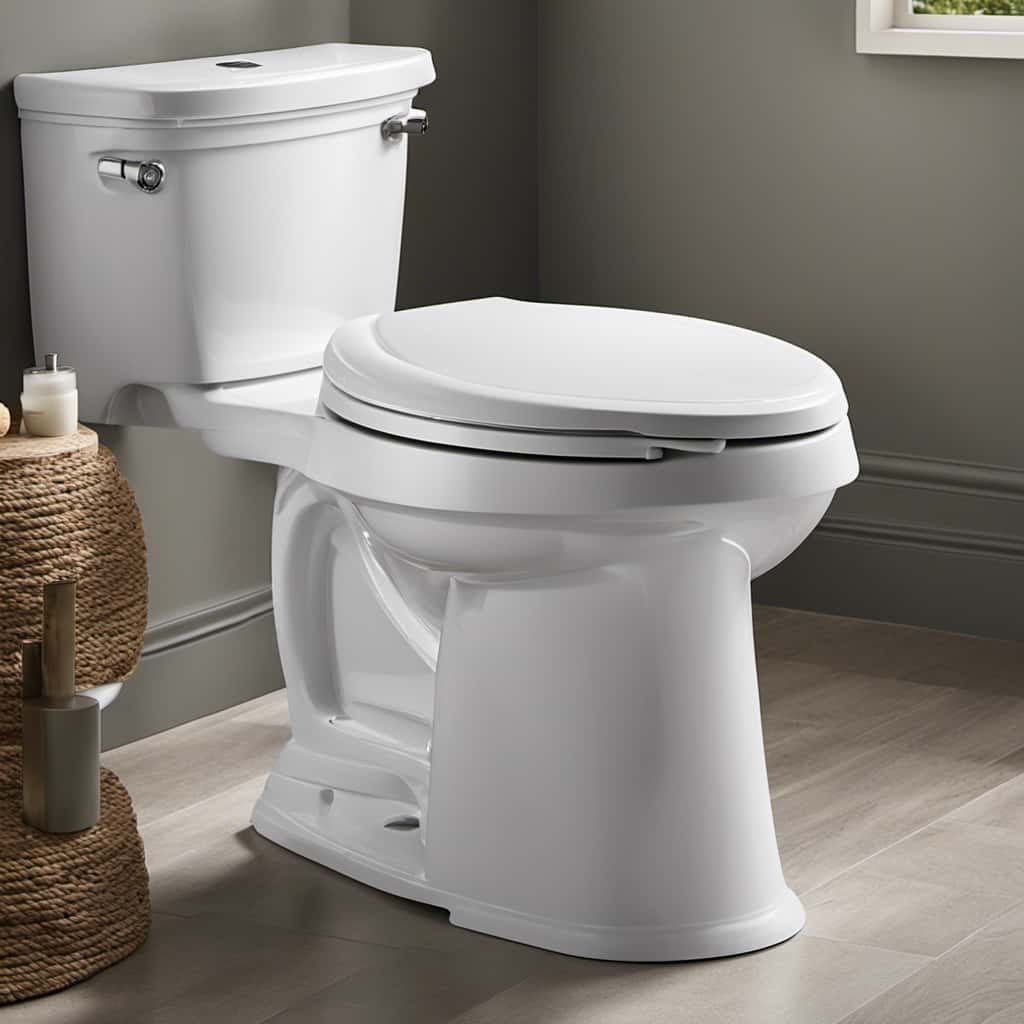
Use a toilet auger or a long-handled tool with a hook at the end to carefully reach into the toilet bowl and try to grasp the object. Gently maneuver the tool around the object, being mindful not to push it further into the plumbing system.
If the object is within reach, carefully lift it out of the toilet. If you encounter any resistance or are unable to retrieve the object, it’s best to stop and call a professional plumber to avoid causing further toilet damage.
Transitioning to the next section, if retrieving the object manually isn’t possible, you can try using a plumbing snake.
Use a Plumbing Snake
Now, let’s move on to using a plumbing snake to retrieve the object from the toilet. A plumbing snake is a handy tool that can be used to unclog toilets and pipes. It consists of a long, flexible metal cable with a coiled end. Here’s how you can use a plumbing snake to tackle the clog and retrieve the flushed object:
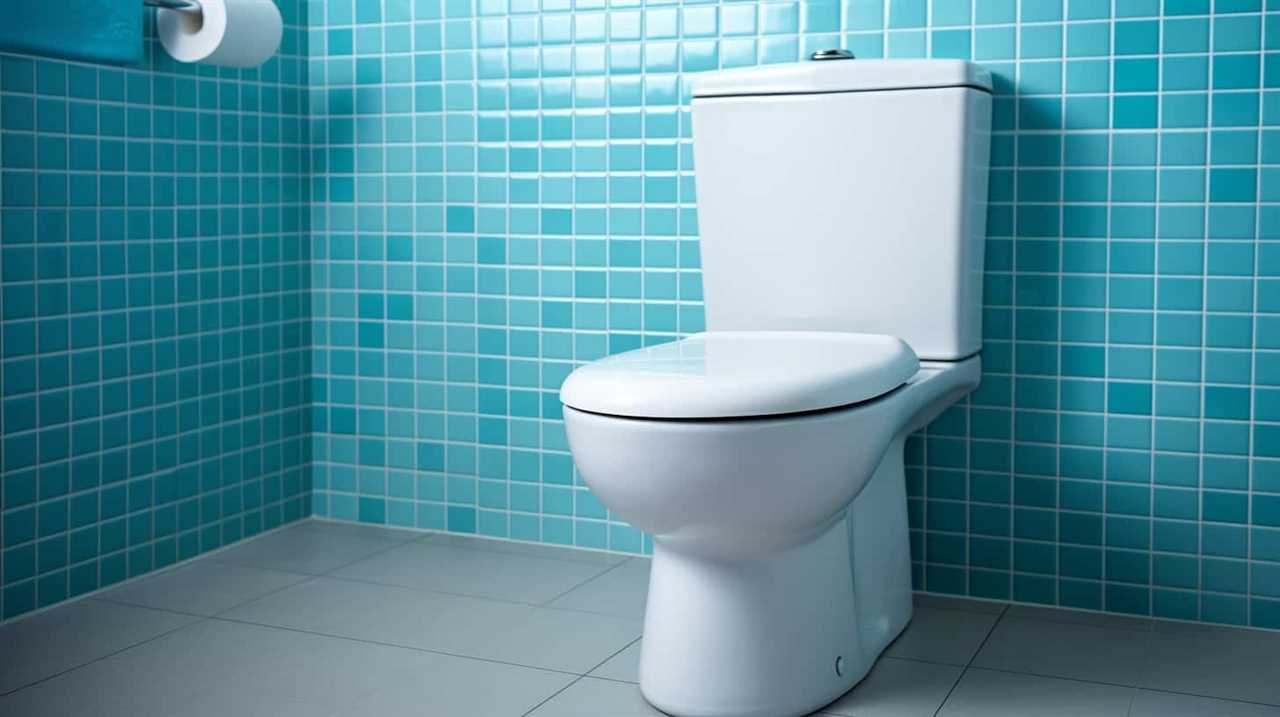
| Step | Instructions |
|---|---|
| 1 | Put on gloves and protective eyewear. |
| 2 | Insert the coiled end of the plumbing snake into the toilet bowl. |
| 3 | Slowly rotate the handle of the snake clockwise to feed it into the drain. |
| 4 | Continue pushing the snake further into the drain until you feel resistance. |
| 5 | Rotate the handle counterclockwise to break up the clog or hook onto the object. |
| 6 | Gently pull the snake back out, taking care not to damage the toilet bowl. |
| 7 | Dispose of the flushed object properly and flush the toilet to ensure it is unclogged. |
Using a plumbing snake is an effective DIY plumbing method to retrieve objects and unclog toilets. Remember to follow these steps carefully to avoid causing further damage.
Seek Professional Help if Necessary
If the object can’t be retrieved using a plumbing snake, we may need to seek professional help. In such cases, it’s advisable to contact a plumber who specializes in toilet repairs and blockage removal. Professional plumbers have the necessary tools, expertise, and experience to handle more complex situations. They can utilize advanced techniques like hydro jetting or drain cameras to locate and remove the object safely.
Seeking professional help ensures that the issue is resolved efficiently and effectively, minimizing any further damage to the plumbing system. Additionally, it’s important to learn from the experience and take steps to prevent future accidents. This includes being mindful of what gets flushed down the toilet and considering the use of drain screens or toilet locks to avoid similar situations in the future.
Frequently Asked Questions
Can I Use a Plunger to Try and Retrieve the Object?
Yes, we can try using a plunger to retrieve the object, but if it doesn’t work, we should consider calling a professional plumber or exploring alternative methods to safely remove the object.
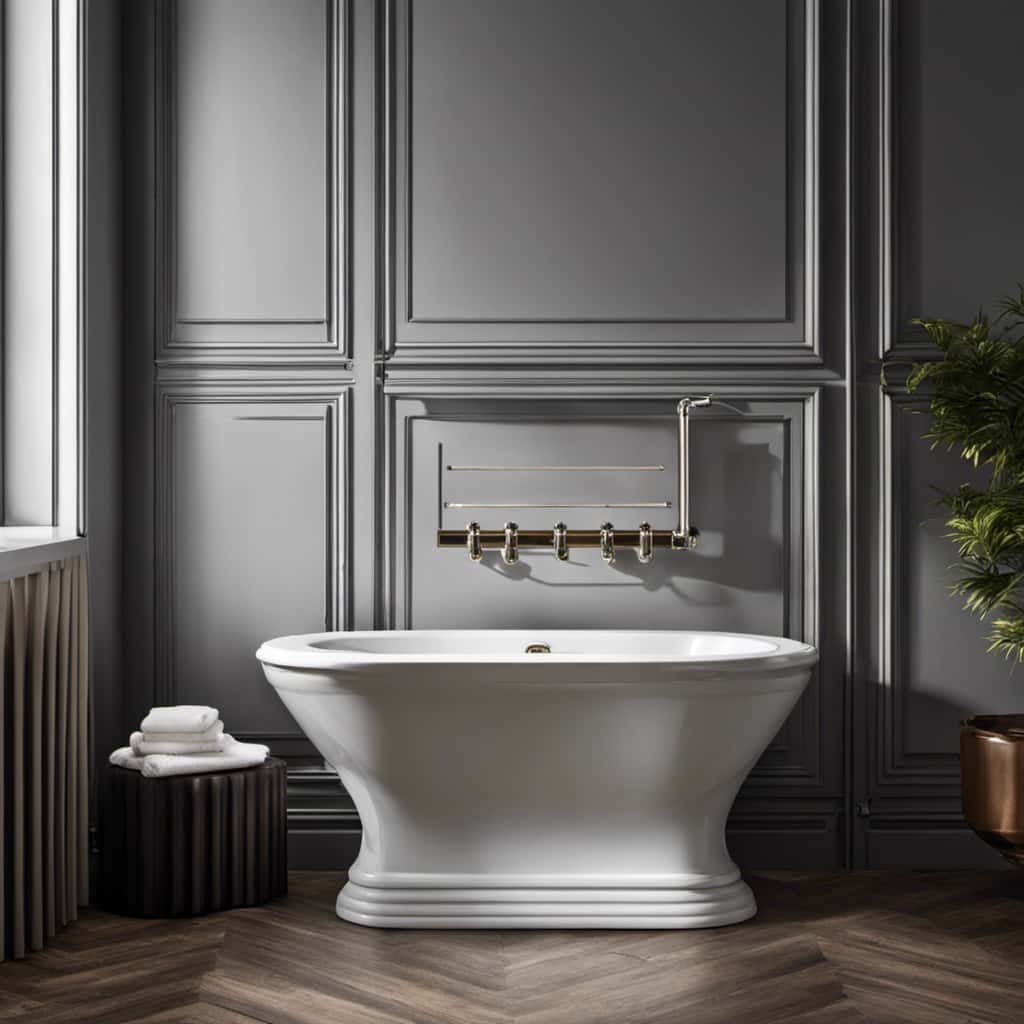
What Are Some Signs That the Object May Have Caused a Blockage in the Plumbing System?
If you notice slow draining, gurgling sounds, or water backing up in other fixtures, these are signs that a large object may have caused a blockage in the plumbing system. To prevent this, be mindful of what you flush and consider using a toilet lock.
Can I Use Chemical Drain Cleaners to Dissolve the Object?
We don’t recommend using chemical drain cleaners to dissolve the object. There are alternative methods, such as using a plunger or a plumbing snake, that are more effective and won’t cause further damage. If these methods don’t work, it’s best to seek professional assistance.
Are There Any Potential Dangers or Risks Associated With Using a Plumbing Snake?
When using a plumbing snake, there are potential risks if not used properly. It is important to follow the proper usage instructions to avoid damaging the pipes or causing further clogs.
Will My Homeowner’s Insurance Cover the Cost of a Professional Plumber if Needed?
Yes, homeowner’s insurance may cover the cost of a professional plumber if needed. However, it’s important to consider DIY methods first to avoid potential risks and dangers.
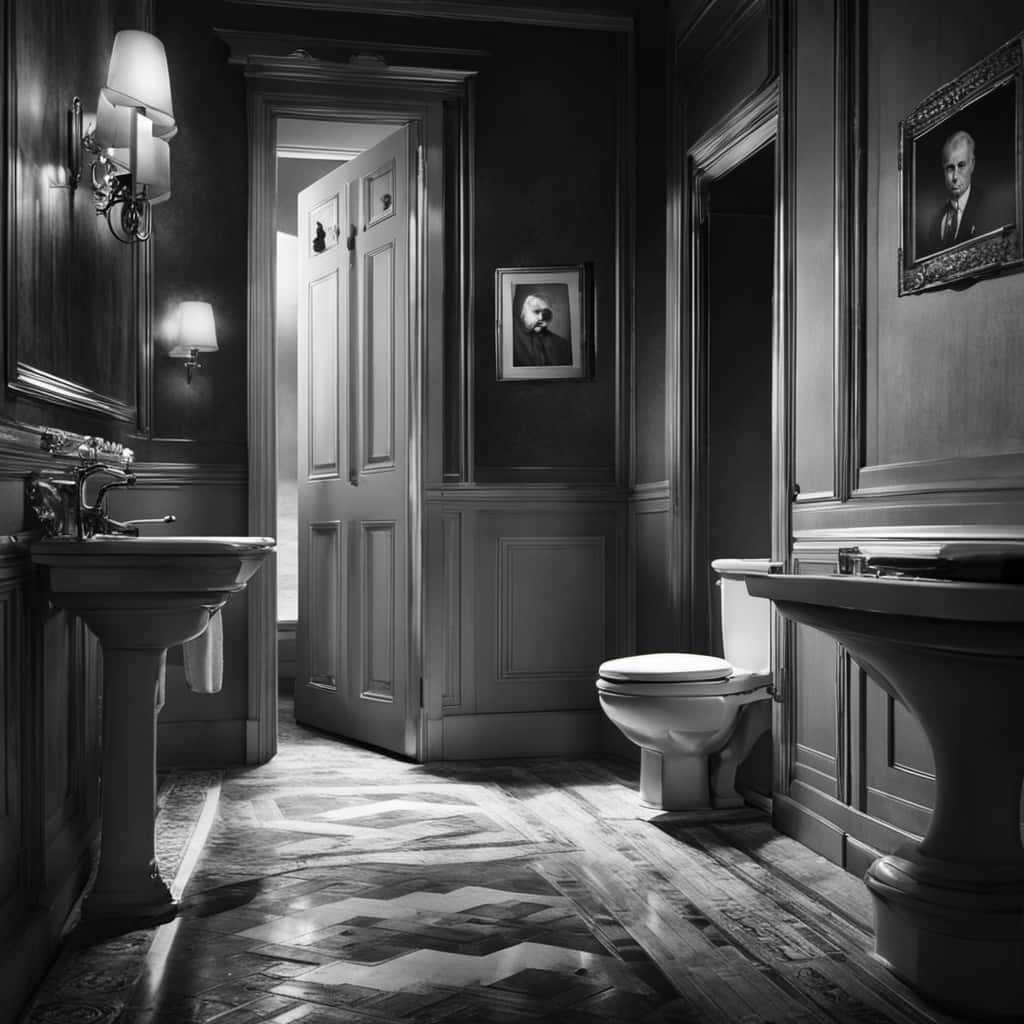
Conclusion
In conclusion, if you find yourself in the unfortunate situation of flushing a large object down the toilet, it’s important to assess the situation calmly and act quickly.
Stop the water flow, try to retrieve the object if possible, and use a plumbing snake if needed. Remember, seeking professional help may be necessary to resolve the issue completely.
Don’t let this mishap send you down the drain like a ship without a captain – take control and tackle the problem head-on.
With an impeccable eye for detail and a passion for bathroom-related, Ava leads our editorial team gracefully and precisely.
Under her guidance, Best Modern Toilet has flourished as the go-to resource for modern bathroom enthusiasts. In her free time, you might find Ava exploring antique shops and looking for vintage bathroom fixtures to add to her collection.
Bathtub
Is It Safe to Flush Toilet Paper Down the Toilet

When it comes to disposing of toilet paper correctly, we all want to ensure we are doing it properly. But is it safe to flush toilet paper down the toilet? In this article, we will investigate the potential plumbing hazards and environmental effects linked to flushing toilet paper.
We will also discuss alternatives to flushing and provide guidelines for proper toilet paper usage.
So, let’s dive in and discover the best way to handle this essential bathroom task.
Key Takeaways
- Flushing toilet paper can lead to clogged pipes and blockages.
- Toilet clogs can make toilets inoperable and require plumber assistance.
- Toilet paper production contributes to deforestation and climate change.
- Using bidet options or eco-friendly alternatives can reduce the need for toilet paper.
Plumbing Risks
One of the main plumbing risks associated with flushing toilet paper down the toilet is the potential for clogged pipes. When toilet paper is flushed, it travels through the plumbing system and can accumulate in the pipes over time. This accumulation can lead to blockages, resulting in toilet clogs and potential sewage backup.

Toilet clogs can be a major inconvenience, causing toilets to become inoperable and requiring the assistance of a plumber to resolve the issue. Additionally, if the clog is severe enough, it can cause sewage backup, which poses health risks and can lead to costly repairs.
To prevent these plumbing risks, it’s important to only flush toilet paper down the toilet and avoid disposing of other items that can cause clogs.
Environmental Impact
Our environmental impact is a major concern when it comes to flushing toilet paper down the toilet. Toilet paper production contributes significantly to deforestation, making it an unsustainable practice. To understand the gravity of this issue, let’s take a look at the environmental impact of toilet paper production.
| Environmental Impact | Explanation |
|---|---|
| Deforestation | The production of toilet paper requires vast amounts of wood pulp, leading to the destruction of forests. This results in the loss of crucial habitats for plants and animals, and contributes to climate change. |
| Water Consumption | The manufacturing process of toilet paper consumes large quantities of water, which can strain local water supplies and deplete freshwater resources. |
| Chemical Usage | The bleaching process used to make toilet paper white often involves the use of harmful chemicals such as chlorine, which can contaminate water sources and harm aquatic life. |
It is essential for us to consider these environmental consequences and explore more sustainable alternatives, such as using recycled or bamboo toilet paper, to minimize our impact on the planet.

Alternatives to Flushing
Let’s explore alternative options for disposing of toilet paper.
One option to consider is using bidet options. Bidets are fixtures that use water to clean the genital area after using the toilet. They’re commonly found in many countries and are becoming more popular worldwide. Bidet options include standalone bidets, bidet attachments that can be added to existing toilets, or handheld bidet sprayers. By using a bidet, you can reduce or even eliminate the need for toilet paper altogether.
Another alternative is using reusable cloths. These can be made from soft, absorbent materials such as cotton or bamboo. After use, simply wash the cloth with soap and water, and it will be ready for reuse. Reusable cloths are an eco-friendly option that can help reduce waste and minimize the environmental impact of toilet paper disposal.
Proper Toilet Paper Usage
To continue the discussion on proper toilet paper usage, we can now delve into the importance of using toilet paper responsibly and ensuring its proper disposal.

When it comes to toilet paper brands, it’s essential to choose ones that are designed to dissolve easily in water. Look for brands that are labeled as septic-safe or biodegradable. These types of toilet paper are specifically formulated to break down quickly, reducing the risk of clogging your plumbing system or causing damage to your septic tank.
Additionally, regular septic tank maintenance is crucial for preventing issues related to toilet paper usage. Regular pumping and inspection can help identify any potential problems before they escalate.
Proper toilet paper usage, combined with septic tank maintenance, ensures a trouble-free and efficient plumbing system.
In the following section, we’ll provide our conclusion and recommendations regarding toilet paper disposal and alternatives.

Conclusion and Recommendations
To sum up our findings on proper toilet paper usage and disposal, we recommend:
- Selecting septic-safe or biodegradable brands that dissolve easily in water.
- Regularly maintaining your septic tank to prevent potential issues.
Here are our top three recommendations for toilet paper disposal and septic tank maintenance:
- Choose septic-safe or biodegradable brands: Opt for toilet paper that’s specifically designed to break down easily in water. These brands are less likely to cause clogs or damage to your septic system.
- Avoid flushing other materials: Never flush anything other than toilet paper down the toilet. Items like wet wipes, sanitary products, or paper towels can lead to blockages and septic tank problems.
- Regularly maintain your septic tank: Schedule regular inspections and pump-outs to ensure that your septic tank is functioning properly. This will help prevent backups, odors, and costly repairs.
Frequently Asked Questions
Can Flushing Toilet Paper Down the Toilet Cause Clogs in the Plumbing System?
Flushing toilet paper down the toilet can cause clogs in the plumbing system, posing clogging risks. Additionally, it can have negative environmental impacts. It’s essential to dispose of toilet paper properly to avoid these issues.
Is There a Risk of Toilet Paper Causing Damage to the Septic Tank?
There are risks associated with flushing toilet paper down the toilet, including potential damage to the septic tank. Additionally, using alternative toilet paper options can have environmental impacts that should be considered.

Are There Any Health Risks Associated With Flushing Toilet Paper Down the Toilet?
Flushing toilet paper poses no health risks and has numerous health benefits, such as maintaining cleanliness and preventing the spread of germs. However, it is important to consider the environmental impact and use eco-friendly alternatives when possible.
Can Flushing Excessive Amounts of Toilet Paper Lead to Problems With the Municipal Sewage System?
Flushing excessive amounts of toilet paper can potentially lead to problems with the municipal sewage system. It is important to consider the potential environmental impact and explore alternatives to flushing toilet paper, such as using bidets or installing a separate waste bin.
Is It Safe to Flush Toilet Paper With Additives, Such as Scented or Moistened Options, Down the Toilet?
Yes, it is safe to flush regular toilet paper down the toilet. However, when it comes to toilet paper with additives like scents or moisture, there are safety concerns and potential environmental impact to consider.
Conclusion
In conclusion, it’s safe to flush toilet paper down the toilet, as long as it’s used in moderation and not excessive amounts.

However, it’s important to be mindful of the potential plumbing risks and environmental impact.
To minimize these risks, consider using alternatives to flushing, such as bidets or wet wipes, and always follow proper toilet paper usage guidelines.
By taking these precautions, we can maintain a functional plumbing system and contribute to a healthier environment.
With an impeccable eye for detail and a passion for bathroom-related, Ava leads our editorial team gracefully and precisely.
Under her guidance, Best Modern Toilet has flourished as the go-to resource for modern bathroom enthusiasts. In her free time, you might find Ava exploring antique shops and looking for vintage bathroom fixtures to add to her collection.
Bathtub
Can You Flush Toilet Paper in Crete Greece

Have you ever been to Crete, Greece and wondered about the toilet paper disposal situation? We have all the information you need!
In this article, we’ll dive into the plumbing system in Crete and explore the do’s and don’ts of toilet paper disposal. We’ll also discuss the environmental impact of flushing toilet paper and provide some alternative options.
So, grab a seat and get ready to learn all about the best ways to handle your toilet paper experience in Crete. Let’s get started!
Key Takeaways
- The plumbing system in Crete operates efficiently, but specific regulations are in place for toilet paper disposal.
- Flushing toilet paper can cause plumbing issues and may not be suitable for older infrastructure.
- Toilet paper should be placed in a separate bin in Crete, and plastic bags are commonly used to line the bins for easy disposal.
- Flushing toilet paper has significant environmental consequences, including clogged pipes, water pollution, and negative impacts on forests and ecosystems.
Plumbing System in Crete
The plumbing system in Crete, Greece, operates efficiently, allowing us to flush toilet paper without any concerns. In Greece, there are specific plumbing regulations in place that dictate the standards for the country’s plumbing infrastructure. These regulations ensure that the plumbing system can handle the disposal of toilet paper without any issues.

However, it’s important to note that there are cultural differences in toilet paper usage in Greece compared to other countries. While it’s common practice in many places to dispose of toilet paper in the toilet, in Greece it’s often recommended to dispose of it in a separate bin provided in the bathroom. This cultural difference is due to the older infrastructure in some parts of Greece, which may not be able to handle large amounts of toilet paper.
Transitioning into the subsequent section about ‘toilet paper disposal in Crete’, let’s explore the proper methods for disposing of toilet paper in this region.
Toilet Paper Disposal in Crete
We can dispose of toilet paper in Crete, Greece, by placing it in a separate bin provided in the bathroom. It’s a common practice in Crete to not flush toilet paper down the toilet due to the plumbing system’s sensitivity. Instead, you’ll find small bins specifically designated for toilet paper disposal in most bathrooms. These bins are usually lined with plastic bags for easy disposal.
It’s important to adhere to this local custom to avoid any plumbing issues. While it may seem unusual for some visitors, it’s a necessary step to ensure the proper functioning of the plumbing system. By disposing of toilet paper in these bins, we can minimize the risk of clogs and maintain the overall cleanliness and hygiene of the bathroom facilities.

Now that we know how to dispose of toilet paper correctly, let’s delve into the environmental impact of flushing toilet paper.
Environmental Impact of Flushing Toilet Paper
As we consider the environmental impact of flushing toilet paper in Crete, Greece, it’s important to recognize the significant amount of waste that can accumulate in the plumbing system. Flushing toilet paper can have a detrimental impact on sewage systems, as the paper can clog pipes and cause blockages. This not only leads to costly repairs, but also contributes to the pollution of our waterways.
Additionally, the sustainability of toilet paper production is a concern. The production of toilet paper requires the cutting down of trees and the use of chemicals, which can have a negative impact on our forests and ecosystems.
Considering these environmental consequences, it’s crucial to explore alternatives to flushing toilet paper in Crete.

Alternatives to Flushing Toilet Paper in Crete
Toilet paper alternatives in Crete include bidets, which can be a more sustainable option for personal hygiene. In addition to bidets, there are several other cultural practices and alternatives to flushing toilet paper in Crete that you may find interesting:
- Water containers: Many households in Crete have water containers next to the toilet. After using the toilet, instead of using toilet paper, you can pour water from the container to clean yourself.
- Handheld bidet sprayers: These devices are similar to a shower head attached to a hose. With a simple press of a button, you can direct a stream of water for cleaning purposes.
- Wet wipes: While not as sustainable as the previous options, wet wipes are commonly used as an alternative to toilet paper in Crete. However, it’s important to dispose of them properly to prevent clogging the plumbing system.
Tips for a Smooth Toilet Paper Experience in Crete
To ensure a smooth toilet paper experience in Crete, it’s advisable to stock up on an ample supply of toilet paper before your trip. While there are toilet paper brands available in Crete, it’s always better to be prepared, especially if you have specific preferences.
Some popular toilet paper brands in Crete include Papernet, Softline, and Katrin. These brands offer a range of options, from standard to extra soft, ensuring comfort during your bathroom visits.
Additionally, it’s important to adhere to proper public restroom etiquette in Crete. Always remember to flush the toilet paper in the provided bins, as the plumbing systems in Crete may not be able to handle flushing it down the toilet.

Frequently Asked Questions
What Is the Average Cost of Plumbing Services in Crete?
The average cost of plumbing services in Crete can vary depending on the specific needs of the project. It is best to contact local plumbing companies for accurate pricing information.
Can I Flush Wet Wipes Down the Toilet in Crete?
Yes, we can flush wet wipes down the toilet in Crete, Greece. However, it is important to note that only flushable wipes should be used. Alternatively, there are other toilet paper options available.
Are Bidets Commonly Found in Crete Homes?
Bidets, a common fixture in European bathrooms, offer a different approach to personal hygiene. In some countries, like Crete, they are commonly found in homes. Cultural differences in bathroom habits make bidets a popular choice.
Is It Safe to Flush Feminine Hygiene Products in Crete?
Yes, it is safe to flush feminine hygiene products in Crete. However, it is important to consider the disposal methods and the environmental impact of flushing these products.

Are There Any Specific Regulations or Restrictions on Toilet Paper Usage in Crete?
In Crete, Greece, there are no specific regulations or restrictions on toilet paper usage. However, it’s worth considering toilet paper alternatives like bidets or wet wipes to minimize the environmental impact of toilet paper usage.
Conclusion
In conclusion, when visiting Crete, it’s important to remember that the plumbing system may not be able to handle flushing toilet paper. Instead, it’s recommended to dispose of it in the provided waste bin.
This practice not only prevents clogs and damage to the plumbing, but also helps protect the beautiful environment of Crete.
So, let’s take the plunge and adapt to this unique aspect of Crete’s toilet etiquette, ensuring a smooth and sustainable experience for all.

With an impeccable eye for detail and a passion for bathroom-related, Ava leads our editorial team gracefully and precisely.
Under her guidance, Best Modern Toilet has flourished as the go-to resource for modern bathroom enthusiasts. In her free time, you might find Ava exploring antique shops and looking for vintage bathroom fixtures to add to her collection.
Bathtub
Can You Flush a Toilet Without the Lid on

Oh, it’s incredible how we often overlook the little things! It’s astonishing to think about the significant impact that something as basic as flushing a toilet can have on our health and the environment.
In this article, we delve into the importance of flushing with the lid on. We’ll explore the potential health risks of flushing without the lid, how it protects your bathroom, and the environmental consequences.
So, buckle up and get ready to master the art of proper toilet etiquette.
Key Takeaways
- Flushing with the lid on prevents the release of bacteria and viruses into the air.
- Flushing without the lid increases the risk of airborne transmission of pathogens.
- Closing the lid before flushing helps maintain a fresh and clean environment.
- Flushing without the lid can lead to increased water wastage and higher utility bills.
The Importance of Flushing With the Lid on
To maximize hygiene and minimize the spread of germs, it’s essential to always flush the toilet with the lid on.

There are several advantages to this practice. First and foremost, closing the lid prevents the release of a plume of bacteria and viruses into the air. When the toilet is flushed without the lid, these microorganisms can reach surfaces in the bathroom, increasing the risk of contamination.
Additionally, keeping the lid closed helps contain odors, maintaining a more pleasant environment.
However, there are also a few disadvantages to consider. Closing the lid requires an extra step and may inconvenience some individuals. Furthermore, if the lid isn’t properly cleaned, it can become a breeding ground for bacteria.
Therefore, while there are some drawbacks, the advantages of flushing with the lid on far outweigh them in terms of hygiene and preventing the spread of germs.

Potential Health Risks of Flushing Without the Lid
Flushing the toilet without the lid poses potential health risks. Here are four reasons why:
- Potential Contamination: When you flush without the lid, tiny water droplets containing bacteria and other microorganisms can be propelled into the air. These droplets can then settle on surfaces in your bathroom, potentially leading to contamination.
- Spread of Bacteria: Flushing without the lid allows bacteria to spread throughout your bathroom. Bacteria from fecal matter can become airborne and settle on items such as toothbrushes, towels, or even your hands, increasing the risk of illness.
- Increased Aerosolization: The force of the flush can cause a higher level of aerosolization, resulting in a greater dispersion of potentially harmful particles. This can be especially concerning if someone in your household is already sick.
- Potential for Airborne Transmission: Certain bacteria and viruses can survive in the air for extended periods. Flushing without the lid increases the chances of these pathogens becoming airborne, leading to potential respiratory infections.
How Flushing With the Lid on Protects Your Bathroom
By keeping the lid on when we flush, we can effectively protect our bathroom from potential contamination and the spread of bacteria.
The benefits of using a toilet lid are numerous. Firstly, it prevents the release of harmful bacteria and viruses into the air. When we flush without the lid, microscopic particles containing fecal matter and urine are dispersed, settling on surfaces and increasing the risk of contamination.
Secondly, the lid creates a barrier that prevents odors from escaping, maintaining a fresh and clean bathroom environment.

Additionally, using the toilet lid reduces the amount of water that splashes out during flushing, minimizing the need for frequent cleaning.
Alternatives to flushing without the lid include closing the lid before flushing or using a bidet, which eliminates the need for flushing altogether.
Environmental Impact of Flushing Without the Lid
Using the toilet without the lid can have negative environmental impacts, especially in terms of water wastage and energy consumption. Here are four reasons why flushing without the lid can be detrimental to the environment:
- Water Conservation: When the lid is left off, water can easily evaporate, leading to unnecessary water loss. This not only wastes a precious resource but also increases the demand on water treatment facilities.
- Sanitation Standards: Flushing without the lid can result in the spread of harmful bacteria and pathogens. The lid acts as a barrier, preventing these microorganisms from escaping into the air and potentially contaminating surfaces in the bathroom.
- Energy Consumption: Without the lid, air can freely circulate in the toilet bowl, causing the water to evaporate more quickly. As a result, the toilet tank needs to refill more frequently, increasing energy usage and contributing to higher utility bills.
- Odor Control: The lid plays a crucial role in containing unpleasant odors. By leaving it off, foul smells can permeate the bathroom, leading to discomfort and the need for additional air fresheners, which can have their own environmental impact.
Tips for Proper Toilet Etiquette
To ensure proper toilet etiquette, we should always remember to close the lid before leaving the bathroom. This simple act not only keeps the bathroom clean and tidy, but also prevents the spread of germs and bacteria. Etiquette reminders can help maintain a hygienic environment for everyone.

Firstly, it’s important to flush the toilet after every use to remove waste and eliminate any unpleasant odors. Additionally, it’s courteous to use toilet paper sparingly and to properly dispose of it in the provided receptacle.
Furthermore, washing hands thoroughly with soap and water is essential to maintain good hygiene. Lastly, it’s considerate to replenish toilet paper and hand soap if necessary, ensuring the next person has a pleasant experience.
Following these etiquette reminders promotes bathroom cleanliness and a positive experience for all.
Frequently Asked Questions
Can Flushing a Toilet Without the Lid on Cause Damage to the Plumbing System?
Flushing a toilet without the lid on can potentially cause plumbing damage and pose health risks. It is important to keep the lid on to prevent objects from falling in, reduce odors, and minimize the spread of bacteria and germs.

Is It True That Flushing Without the Lid Can Lead to the Spread of Bacteria and Germs?
Yes, flushing without the lid can lead to the spread of bacteria and germs. To prevent this, it is important to always flush with the lid down and practice proper sanitation methods.
What Are the Potential Health Risks Associated With Flushing Without the Lid?
Potential contamination and bacterial transmission are the main health risks associated with flushing without the lid. Without the lid, droplets containing bacteria and germs can be propelled into the air, increasing the chances of spreading illness.
How Does Flushing With the Lid on Protect the Bathroom From Unpleasant Odors?
Flushing without the lid can lead to unpleasant bathroom odors. The lid acts as a barrier, preventing the release of odorous gases into the air. It’s important to keep the lid on to maintain a fresh and odor-free bathroom environment.
Are There Any Environmental Consequences of Flushing Without the Lid?
There are environmental consequences to flushing without the lid on. It can lead to the release of unpleasant odors, which negatively impact air quality. Additionally, it can result in water wastage, reducing our efforts for water conservation.

Conclusion
In conclusion, it’s crucial to always flush the toilet with the lid on to maintain proper hygiene and protect our health. Flushing without the lid can lead to the spread of harmful bacteria and viruses, posing potential health risks.
Additionally, keeping the lid closed helps prevent any unwanted odors from escaping and maintains a clean and pleasant bathroom environment.
Let’s remember to practice proper toilet etiquette by always flushing with the lid securely in place.
With an impeccable eye for detail and a passion for bathroom-related, Ava leads our editorial team gracefully and precisely.
Under her guidance, Best Modern Toilet has flourished as the go-to resource for modern bathroom enthusiasts. In her free time, you might find Ava exploring antique shops and looking for vintage bathroom fixtures to add to her collection.
-

 Bathroom Enhancements2 months ago
Bathroom Enhancements2 months agoWill Hot Bath Lower Blood Pressure
-

 FAQ - Advanced Bathroom Queries3 months ago
FAQ - Advanced Bathroom Queries3 months agoWhich Countries Use Bidets the Most
-

 Reviews1 month ago
Reviews1 month agoLDian Smart Toilet Review [2024]
-

 Reviews2 months ago
Reviews2 months agoKohler Innate Smart Toilet Review [2024]
-

 Reviews2 months ago
Reviews2 months agoKohler NUMI 2.0 Smart Toilet Review [2024]
-

 Reviews2 months ago
Reviews2 months agoCANEST Smart Toilet Review: The Ultimate Bathroom Upgrade [2024]
-

 Toilet Types3 months ago
Toilet Types3 months agoAre Bleach Tablets Bad for Your Toilet
-

 Reviews2 months ago
Reviews2 months agoWoodbridge B0970S Smart Bidet Toilet Review [2024]






















